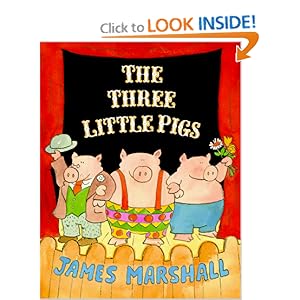
Marshall, James. The Three Little Pigs. Dial Books for Young Readers. 1989. ISBN: 0803705913
The classic tale of the Three Little Pigs takes on a story of three pig brothers who were sent out by their mother, an old sow, to seek their fortune. The first little pig sees a man who has a load of straw and buys it from him, claiming that he will build his house with it. The man tells him it is not a good idea but the pig tells him to mind his own business and builds the straw house anyway in record time. Very soon a “lean and hungry wolf” tries to get into the pigs house. The pig refuses to let him in, so the wolf does, as expected, and says, “Then I’ll huff and I’ll puff and I’ll blow your house in.” Once the house falls down “he gobbled up the little pig.” The second little pig has a similar experience of house building with some sticks. He too meets the fate of the hungry wolf and is gobbled up. The third little pig is depicted as a smart one who outwits the wolf by telling him he’ll meet him at the farm, the orchard and even the fair at a later time than he really will be out. Once the wolf catches on to this, he goes to get the little pig at the fair but the pig is able to scare the wolf away by getting in a butter churn and rolling down the hill at him. By the end, the wolf goes down the chimney into the little pig’s awaiting, hot iron pot. Then, the little pig gobbles up the wolf.
The plot of this story is simple and action based, as is necessary for traditional tales. The story does “move forward logically with a quick ebb and flow of action” (Vardell 93). The theme does follow the basics by being one of the “big, global messages with a clear stance on the importance of good triumphing over evil.” The gory side to this is a bit much and I was trying to recall the original “Three Little Pigs” cartoon that I saw as a kid. In Disney’s 1933 version of “The Three Little Pigs” we first hear the memorable song “Who’s Afraid of the Big, Bad Wolf.” As I watched this version, I noticed that the first two pigs seem much more jovial, naive, singing pigs whereas the third little pig is a hard-working strong type (more than likely a cultural nod to the American way of life in the 30s). It also incorporates the idea of “a wolf in sheep’s clothing” as Big, Bad tries to outwit the first two pigs. The apple orchard that is mentioned in Marshall’s version is seen in the Disney version, but only as the pigs escape as apples fall on the wolf’s head. The ending is without any gobbling and the wolf is just shot back out of the chimney with a burned bottom that sends him running away for good.
It also cracks me up that the third little pig has a picture of “Mother” on the wall - a large sow, sucking her piglets. “Father” is a link of sausages!
Publisher’s Weekly (July 14, 1989) reviewed Marshall’s book by stating, “Deadpan as ever, Marshall begins this one in a traditional way: the old sow sends her piglets off into the big world. Despite the protests of the tradesmen who sell them materials, both the first and second pig construct their flimsy houses of straw and sticks. In short order, they are gobbled up by the wolf. The pig who invests in bricks, of course, does the gobbling when he encounters the wolf, after a merry mass of near misses that blithely build suspense. There are fairy tales, and there are Marshall's tales. Readers can also be forgiven for preferring his over all the rest.” Other reviews state that Marshall writes “half-fractured fairy-tales” so I think I would like to read more of Marshall’s takes on familiar stories.
For activities in the classroom or library, perhaps comparing film versions to book variations would be an interesting project. I can even see having older students write compare and contrast essays on the various versions of these familiar tales. It would be something reluctant readers could get into because they would have easy to read books and cartoons involved. Honors or college freshman would be able to examine the cultural and historical impact the different variations have. Other familiar tales such as “Cinderella” or “Little Red Riding Hood” would work for this project as well.
Reference
Vardell, Sylvia M. Children’s Literature in Action. Libraries Unlimited. Westport, CT. 2008
No comments:
Post a Comment